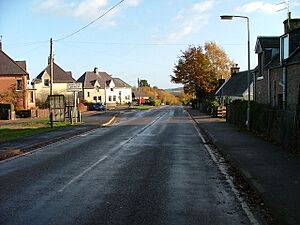Kirkhill, Highland facts for kids
Quick facts for kids Kirkhill
|
|
|---|---|
 The B9164, the main street running through Kirkhill |
|
| Population | 750 (2020) |
| OS grid reference | NH556453 |
| Council area | |
| Lieutenancy area |
|
| Country | Scotland |
| Sovereign state | United Kingdom |
| Post town | Inverness |
| Postcode district | IV5 7 |
| Dialling code | 01463 |
| Police | Northern |
| Fire | Highlands and Islands |
| Ambulance | Scottish |
| EU Parliament | Scotland |
| UK Parliament |
|
| Scottish Parliament | |
Kirkhill (pronounced Kirk-hill) is a small village in the beautiful Highland area of Scotland. Its name in Scottish Gaelic is Cnoc Mhoire, which means "Big Hill". It's located about 10 miles (16 km) west of Inverness. It is also close to Beauly, a town about 2 miles (3.2 km) away. The village is near the southern entrance of the Beauly Firth, which is a narrow sea inlet.
The village of Kirkhill also includes the historic area of Wardlaw to its north. These two areas officially joined together in the year 1618. Kirkhill has its own village hall, which is a community building. It also has a primary school called Kirkhill Primary. This school serves children from Kirkhill and nearby places. These areas include Inchmore, Lentran, Drumchardine, Cabrich, Bunchrew, Clunes, and Newtonhill.
Exploring Kirkhill's History
The Wardlaw Mausoleum
One of the most interesting historical sites in Kirkhill is the Wardlaw Mausoleum. A mausoleum is a building that acts as a tomb or a place where people are buried. This one was built in 1634. It was the special burial place for the leaders, or Chiefs, of Clan Fraser of Lovat. A clan is a group of families who are related and share a common ancestor. The Fraser family used this mausoleum until the early 1800s.
By the 1990s, the mausoleum was in poor condition and needed repairs. So, a group called the Wardlaw Mausoleum Trust was created. Their goal was to fix and preserve this important historical building.
The Legend of Lord Lovat
In 1722, Simon Fraser, 11th Lord Lovat, who was a chief of the clan, made changes to the mausoleum. He had the roof raised and a tower built on top. Lord Lovat was involved in the Jacobite rebellion. This was a series of uprisings in Great Britain that aimed to restore the Stuart family to the throne.
After his role in the rebellion, a famous legend began about Lord Lovat's body. People believed his body was secretly moved from a church in London to the family mausoleum in Kirkhill. However, in 2018, scientists from the University of Dundee studied what was thought to be his skeleton. They found that the bones actually belonged to a young woman, not Lord Lovat. This showed that the legend was not true.
See also
 In Spanish: Kirkhill para niños
In Spanish: Kirkhill para niños



